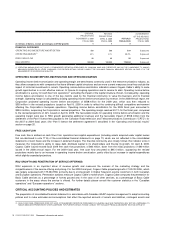Cogeco 2009 Annual Report Download - page 21
Download and view the complete annual report
Please find page 21 of the 2009 Cogeco annual report below. You can navigate through the pages in the report by either clicking on the pages listed below, or by using the keyword search tool below to find specific information within the annual report.20 COGECO CABLE INC. 2009 Management’s discussion and analysis
The growth in penetration of broadband connections of all types, the rapid increase in transmission speeds offered by competitors in
the market and the deployment of the more powerful and efficient MPEG-4 video compression standard and of other similar
compression technologies promote the increased distribution and consumption of video content directly over the Internet. This may
eventually lead to fragmentation of the retail market for existing Analogue and Digital Television distribution services provided by the
Corporation and gradual disintermediation through direct transactions between video content suppliers and the Corporation’s
customers. In this context, revenue and margins derived from the Corporation’s HSI access services may not entirely compensate
for the eventual loss of revenue or margin derived from the Corporation’s Television services in the future. Alternative voice and data
communications services are proliferating over the Internet, resulting in the risk that fragmentation and disintermediation may also
occur in the future with respect to the Corporation’s Telephony service.
Electronic communications increasingly rely on advanced security technology, terminal devices, control systems and software to
ensure conditional access, appropriate billing and service integrity. Security and business systems technology is provided worldwide
by a small pool of global suppliers on a proprietary basis. As other providers of electronic communications, the Corporation depends
on the effectiveness of such technology for many of its services and the ability of technological solutions providers to offer cost-
effective and timely solutions to deal with security breaches or new developments required in the marketplace.
REGULATORY RISKS
In Canada, electronic communications facilities and services are subject to regulatory requirements depending mainly on the type of
facilities involved, the incumbent status of service providers and their relative market power, the technology used and whether the
activities are categorized as telecommunications or broadcasting. Canadian cable telecommunications facilities and services are
subject to various requirements, mainly under federal legislation governing broadcasting, radiocommunication, telecommunications,
copyright and privacy, and under provincial legislation governing consumer protection and access to certain municipal property and
municipally-owned support structures. Broadcasting licences and broadcasting certificates are still required for the operation of
larger cable systems. Various licence and licence exemption conditions apply in Canada. Canadian cable operators are also subject
to Canadian ownership and control requirements. Changes in the regulatory framework or licences, which are subject to periodic
renewal, may affect the Corporation’s existing business activities or future prospects.
The CRTC has initiated earlier this year yet another broadcasting proceeding to consider the implementation of a form of fee-for-
carriage (“FFC”) to be paid by Canadian cable and satellite broadcasting distributors to Canadian conventional over-the-air
television broadcasters for the cable and satellite distribution of their local and regional signals. Cogeco Cable will continue to
strongly oppose any form of FFC. Such a measure, if implemented by the CRTC, could have an adverse impact on the cost of basic
cable service and hence, on RGU growth and the purchase of optional television tiers or on-demand television services. The
outcome of this public proceeding will likely be known in the 2010 fiscal year. Cable and satellite broadcasting distributors have
indicated that any FFC would be passed on to customers, while television broadcasters have advocated that cable and satellite
distributors absorb the cost of FFC. Following the issuance of an Order-in-Council requiring the CRTC to report on the impact of
FFC on consumers and on the Canadian broadcasting system, the CRTC has launched a parallel proceeding to consider the
affordability of television services, including a low-cost basic television service and more discrete service options for cable and
satellite customers.
In addition to the mandatory contribution amounting to 5% of gross revenue derived from broadcasting activities that licenced cable
and satellite broadcasting distributors are already required to pay in order to support Canadian television program production and
local expression in television, the CRTC has decided to impose an additional levy amounting to 1.5% of gross revenue derived from
their broadcasting activities, payable monthly starting in September 2009, in order to finance a new Local Programming
Improvement Fund (“LPIF”) for the benefit of conventional television broadcasters operating local stations in Canadian television
markets of less than 1 million in population. Cogeco Cable may not be able to pass on the full cost of this additional levy to its
customers in the 2010 fiscal year.
By way of judicial reference, the CRTC has asked the Federal Court of Appeal to determine whether it has jurisdiction under the
Broadcasting Act to regulate Internet Service Providers (“ISP”s) where ISPs provide access through the Internet to “broadcasting”
requested by end-users. Cogeco Cable has decided to participate in this reference with a view to have the Court determine that the
Commission does not have such jurisdiction. This determination will be important in light of proposals made to the CRTC to impose
also a levy of 2.5% of gross revenue derived from ISP activities to further support Canadian programming content.
The CRTC will hold a public hearing starting on January 11, 2010 to consider the appropriateness of mandating certain wholesale
high-speed access services for large incumbent telephone companies as well as for large cable telecommunications carriers. As
part of this telecommunications proceeding, third party competitors are seeking regulated wholesale access to cable head ends and
to dedicated 6 MHz channels on Cogeco Cable’s network over and above the third party Internet access (“TPIA”) services already
provided under the terms of a third party access tariff approved by the CRTC. Since Cogeco Cable’s network is a shared network
between various users and between various broadcasting and telecommunications services, mandated access by third parties to
























